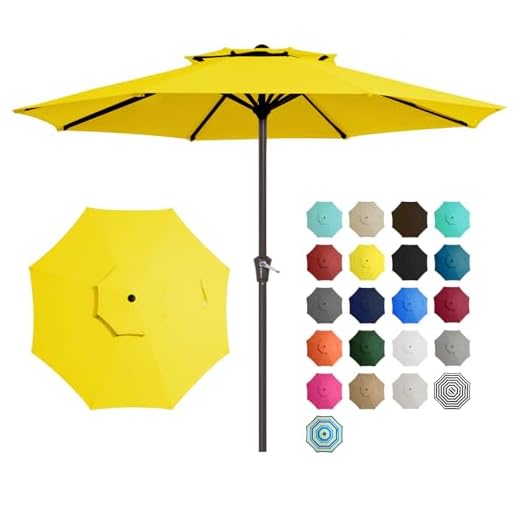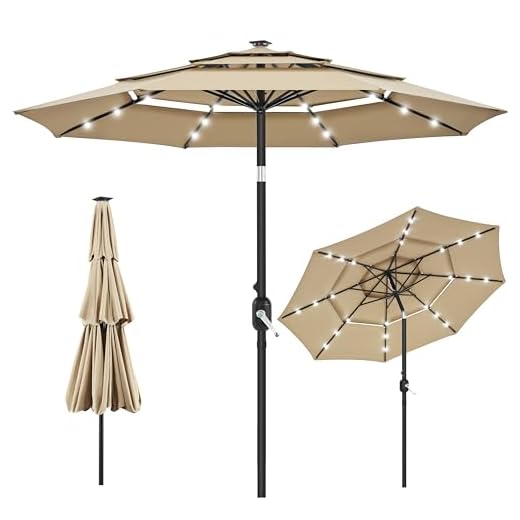




Utilizing weighted bases is a practical approach to prevent your outdoor shade structure from tipping over. These bases provide stability and can be filled with sand or water, ensuring your canopy remains upright even in breezy conditions.
This article focuses on the various methods to protect your outdoor shade solution from wind and other elements. Homeowners seeking to maintain their outdoor spaces will find valuable insights here, as well as tips on selecting the right accessories to enhance stability.
Key recommendations include using tie-down straps, investing in wind-resistant designs, and employing covers when the structure is not in use. Each suggestion aims to enhance the longevity and functionality of your outdoor shade, allowing for enjoyable times spent outside.
Best Way to Secure Your Outdoor Canopy
Utilizing a weighted base is an effective method for stabilizing your outdoor canopy. These bases can be filled with water or sand, providing necessary heft to withstand wind gusts and prevent tipping. Ensure the base is compatible with the pole diameter of your structure for optimal support.
In addition to using a weighted base, consider anchoring the pole to a deck or patio surface. This can be achieved through brackets or straps designed for outdoor use. Properly securing the pole will mitigate the risk of movement during breezy conditions.
Additional Methods for Stability
- Wind-resistant canopies: Opt for designs that are specifically engineered to withstand strong winds, featuring reinforced fabrics and sturdy frames.
- Adjustable height: Set the canopy at a lower height when expecting windy weather, reducing its exposure and risk of damage.
- Taking it down: If winds become severe, the safest option is to disassemble the canopy. Store it in a dry place to prolong its lifespan.
Regular maintenance is also essential. Inspect the canopy for wear and tear, especially after harsh weather. Tightening loose screws and replacing frayed fabric will enhance durability.
By implementing these strategies, the outdoor shade structure will remain stable and functional throughout the season.
Choosing the Right Base for Stability
For ensuring that your outdoor shade structure remains upright during breezy conditions, selecting an appropriate support is fundamental. A sturdy base can prevent tipping and enhance durability. The weight and design of the base should align with the size and style of the canopy you are using.
Consider options like filled bases that can be weighted with sand or water, providing the necessary mass to resist strong winds. Additionally, you may explore various materials, such as concrete, plastic, or metal, each offering distinct benefits in terms of stability and aesthetics.
Factors to Consider
- Weight: Heavier bases are less likely to move or tip over. Aim for a minimum weight according to the umbrella’s size.
- Shape: Round or square bases provide different levels of stability. Assess which fits better with your setup.
- Portability: If you need to move the structure frequently, look for bases that are easy to handle without compromising stability.
- Compatibility: Ensure that the base fits securely with the pole diameter of the shade structure.
In addition to these factors, consider weather conditions in your area. If storms are common, a heavier and more robust base is advisable. If you live in a calm environment, you may opt for a lighter option for easy mobility and storage.
Utilizing Wind Resistant Features
Incorporating wind-resistant elements into outdoor shading solutions significantly enhances their durability during blustery conditions. Features such as double-vented canopies allow wind to pass through, reducing lift and the risk of tipping over.
Investing in sturdy frames constructed from materials like aluminum or fiberglass ensures stability. These materials are less prone to corrosion and can withstand intense gusts better than weaker alternatives. Additionally, weighted bases are crucial; choosing heavier options can prevent unwanted movement.
Key Attributes
- Vented Canopy: Facilitates airflow, minimizing lift.
- Sturdy Frame: Aluminum or fiberglass provides enhanced resilience.
- Weighted Base: A heavier foundation reduces risk of tipping.
- Adjustable Height: Lowering the height can lower wind resistance.
Regular maintenance is also vital. Inspecting for wear and tear on seams or frames ensures longevity. Reinforcing any loose components can prevent accidents.
By focusing on these attributes, outdoor shading options can maintain their integrity and functionality even in challenging weather conditions.
Implementing Tie-Down Systems for Extra Security
Utilizing a tie-down system can significantly enhance the stability of your outdoor shade structure, especially during adverse weather conditions. These systems provide a reliable method to anchor the canopy securely, preventing it from being displaced by wind gusts.
Consider the installation of durable straps or cables that can be affixed to the base or frame of the shade structure. These materials should be weather-resistant to withstand the elements throughout the seasons. Additionally, using ground anchors can offer added support, ensuring that your shade remains upright and stable.
Types of Tie-Down Systems
- Strap Systems: Heavy-duty straps can be looped around the frame and secured to ground stakes.
- Cable Systems: Steel cables can provide robust support and can be anchored to concrete or heavy objects.
- Sandbags: Placing weighted bags at the base of the structure can help prevent movement.
When implementing these systems, ensure that the tie-downs are tight but not excessively so, which could damage the frame. Regularly inspect the components for wear and tear to maintain their effectiveness.
Using a combination of these methods will contribute to a safer and more secure outdoor environment. Each system can be tailored to fit the specific conditions and location of your shade structure.
Regular Maintenance to Prevent Damage
Inspecting the structure regularly is paramount. Look for any signs of wear, such as frayed fabric or loose fittings, which can compromise stability. Addressing these issues promptly can prolong the lifespan of your outdoor shade solution.
Cleaning the canopy and frame periodically helps prevent the buildup of dirt and mildew. Use a soft brush and mild soapy water for the fabric, and a damp cloth for the metal components. Make sure to rinse thoroughly to avoid residue.
Additional Tips for Maintenance
- Storage: When not in use, store the shade unit in a dry place. If possible, disassemble it to prevent any strain on the joints.
- Protective Covers: Consider using a cover designed for outdoor use to shield it from the elements during off-seasons.
- Check Hardware: Regularly inspect bolts and screws for tightness, replacing any that show signs of rust or corrosion.
- Weather Considerations: In areas prone to high winds, it’s wise to take down the structure when storms are forecasted.
By incorporating these practices into your routine, you can significantly reduce the risk of damage and ensure that your outdoor shade remains functional and aesthetically pleasing for years to come.
Seasonal Storage Tips for Longevity
Proper storage during off-seasons can significantly extend the lifespan of your outdoor shade structure. Begin by cleaning the fabric thoroughly to remove dirt and mildew, which can cause deterioration over time.
Once cleaned, ensure that the frame is free of rust or damage. Applying a protective coating can prevent corrosion and maintain its integrity.
- Disassemble components if possible to save space and reduce stress on joints.
- Use a storage bag specifically designed for your type of shade structure to protect against dust and moisture.
- Store indoors in a dry, cool place to avoid exposure to extreme temperatures and humidity.
- Position carefully to prevent crushing or bending; avoid stacking heavy items on top.
- Inspect regularly during storage for any signs of wear or damage that may need addressing.
Implementing these strategies will help maintain the quality and functionality of your outdoor shade apparatus, ensuring it remains a reliable feature for your outdoor space.
Best way to secure patio umbrella
Features
| Part Number | FUB41B |
| Model | FUB41B |
| Color | Black |
| Release Date | 2023-12-22T00:00:01Z |
Features
| Part Number | 4336583223 |
| Model | 4336583223 |
| Color | TAN |
| Size | 9 FT |
Features
| Color | Yellow |
| Size | 11FT |
Features
| Part Number | YT-00144561 |
| Color | Tan |
| Size | 10ft |
Features
| Color | Oatmeal |
| Size | 10FT |
Video:
FAQ:
What are the best methods to secure a patio umbrella during windy conditions?
To keep a patio umbrella stable in windy conditions, consider using a heavy base specifically designed for umbrellas, as this will provide the necessary weight to prevent tipping. Additionally, you can tie down the umbrella with straps or ropes to nearby structures or anchor points. Another option is to use a wind-resistant umbrella that comes with features like reinforced ribs and a sturdy frame. If possible, close the umbrella when strong winds are expected, to protect it from damage.
How can I prevent my patio umbrella from blowing away?
Preventing a patio umbrella from blowing away involves a few key strategies. First, choose a base that is heavy enough to support the size of your umbrella. A base filled with sand or water offers stability. Second, use ground anchors if your umbrella has a pole that can be secured to the ground. If your umbrella is portable, consider bringing it indoors during bad weather. Lastly, look for umbrellas with built-in wind vents, which allow air to flow through without creating lift that can cause the umbrella to overturn.
What size base do I need for my patio umbrella?
The size of the base you need for your patio umbrella depends on the diameter and height of the umbrella. Generally, a base should weigh at least 10 pounds for every foot of the umbrella’s height. For example, a 7.5-foot umbrella typically requires a base weighing around 40-50 pounds. If the umbrella is larger, such as 9 or 11 feet, consider a base of 70-100 pounds. Always refer to the manufacturer’s specifications for the best recommendations.
Are there any specific types of patio umbrellas designed for high winds?
Yes, there are patio umbrellas specifically designed to withstand high winds. Look for features such as reinforced frames, double-vented canopies, and heavy-duty materials. Umbrellas with a tilt mechanism can also help reduce wind resistance by allowing you to adjust the angle. Brands that focus on outdoor furniture often have models tested for durability in windy conditions, making them a reliable choice for areas prone to gusty weather.
What should I do if my patio umbrella is damaged by wind?
If your patio umbrella sustains damage from wind, first assess the extent of the damage. If the canopy is torn or ripped, you may be able to patch it or replace it with a new one. If the frame is bent or broken, check if it can be repaired or if you need to purchase a new umbrella. Make sure to store your umbrella properly when not in use, especially during off-seasons, and consider investing in a protective cover to prolong its life. Keeping the umbrella closed during storms can also help prevent future damage.








